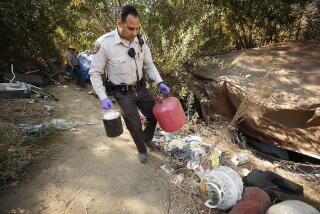Mayoral Candidate Golding Unveils Plan to Fund Hiring of More Police : Politics: The San Diego Police Officers’ Assn., which first endorsed Roberts, gives Golding the nod.
- Share via
County Supervisor Susan Golding unveiled a plan Wednesday that may ensure funding for new San Diego police officers and two police substations if she is elected mayor in November.
Golding announced her “Public Protection and Expenditure Control Plan” after the Police Officers’ Assn. formally endorsed her mayoral candidacy.
The plan is twofold: An ordinance that Golding hopes the City Council will adopt calls for a freeze in property tax revenue at current levels. The annual increase--which has averaged about $10 million a year since 1986--would be earmarked for the hiring of new officers. In the past, that money has been spent on assorted city services at the council’s discretion.
In addition to the ordinance, Golding’s plan would impose a temporary citywide impact fee on all new residential development. Those fees, which she estimated at roughly $49 per single family unit, would pay for the construction of Central and Mid-City police substations.
Golding’s proposal is the latest in a series of attempts to create a greater police presence on San Diego streets, which are patrolled by fewer officers per thousand residents than any major city in the country.
“Public safety has not been getting from the council the money it deserves,” Police Officers’ Assn. President Harry Eastus said in support of Golding’s plan. “You can’t take the 20 top items in the (budget) and have public safety be No. 10, when the City Charter says safety is No. 1.”
While politicians have said public safety is a priority, the search for new officer funds has proved contentious during the budget crisis.
The Police Officers’ Assn. recently abandoned its signature drive for a ballot initiative that would have required the City Council to spend $145 million on 1,313 new police officers by the year 2000.
That initiative, which the council refused to place on the ballot by a 6-3 vote in February, was dubbed by some council members, the city manager’s office and the Police Officers’ Assn. itself as financially untenable at a time when the city is grappling with a budget deficit expected to top $40 million.
The association agreed to stop collecting signatures in exchange for the city’s approval of a two-year police labor contract and its willingness to hire 250 new officers by 1998.
Michael Abrams, a spokesman for City Councilman Ron Roberts, said Roberts is encouraged by Golding’s plan. “He’d look really closely at anything that came in and proposed expanded funding for the police force,” Abrams said. The Police Officers’ Assn. previously endorsed Roberts for mayor, but he did not garner enough votes in the primary to remain in the race.
Others were more skeptical.
“The question is what that $10 million is going to come away from. This doesn’t create new money, so if you’re taking $10 million from the general fund, we would want to know what you’re taking it away from,” said Paul Downey, spokesman for Mayor Maureen O’Connor.
On Wednesday, Golding criticized mayoral candidate Peter Navarro’s plan to fund a greater police presence.
Navarro is collecting signatures for a ballot initiative that would impose impact fees on all new development to pay for police facilities and offset the decline in police protection. He decided last month not to try to put the initiative on the November ballot after Golding accused him of using it as a vehicle for his mayoral campaign.
Navarro questioned the legality of imposing a city-wide impact fee to pay for the two substations Golding’s plan will fund. “Any developer could challenge that and win in court,” Navarro said.
He called the plan to earmark property tax increases for more police officers a “cruel joke.”
“She refused to explain where and what is going to be cut everywhere else in the budget,” he said. “It’s basically only half a plan at that. A responsible proposal would identify what’s going to be cut.”
More to Read
Sign up for Essential California
The most important California stories and recommendations in your inbox every morning.
You may occasionally receive promotional content from the Los Angeles Times.














